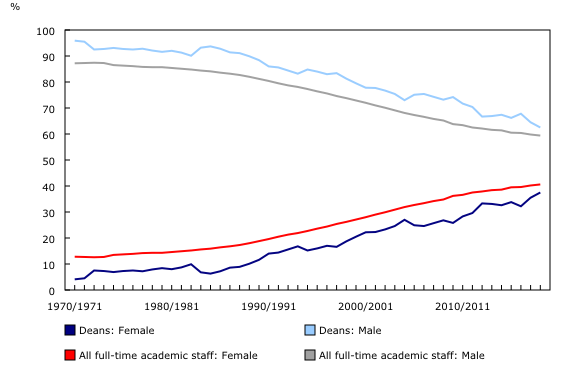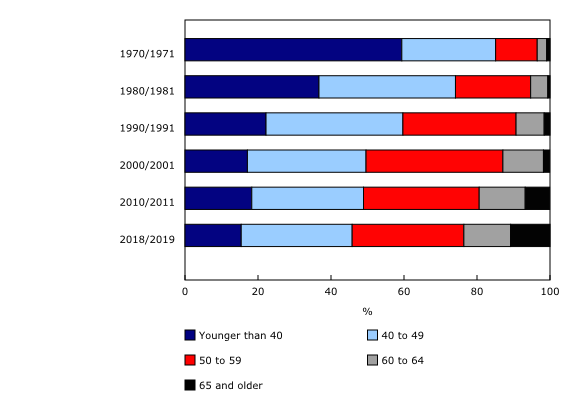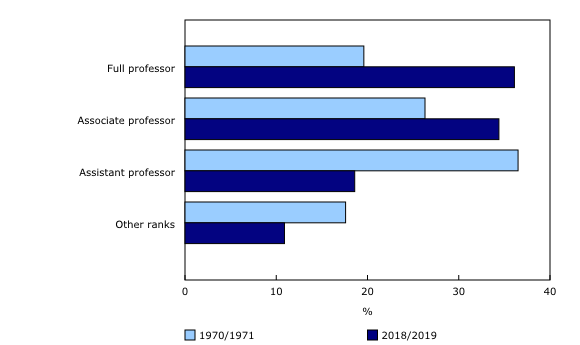Number and salaries of full-time teaching staff at Canadian universities (final), 2018/2019
Archived Content
Information identified as archived is provided for reference, research or recordkeeping purposes. It is not subject to the Government of Canada Web Standards and has not been altered or updated since it was archived. Please "contact us" to request a format other than those available.
Released: 2019-11-25
There are increasing numbers of women among the full-time academic teaching staff at Canadian public universities and their presence is growing in senior administrative roles. At the same time, the professoriate is getting older. This reflects changes in the Canadian workforce since the 1970s, where the employment rate for women aged 25 to 54 rose from 49% in 1976 to 79% in 2018, while the rate for women and men older than 65 rose from 9% to 13%.
Overall, there were 46,440 full-time academic teaching staff at Canadian public universities in 2018/2019, up 0.9% from 2017/2018.
Increasing representation of women
Over the years, women have comprised an increasing share of full-time academic teaching staff in Canadian universities. In 2018/2019, 41% of full-time academic teaching staff were women, compared with 13% in 1970/1971. By way of comparison, in 2018, 47% of the Canadian workforce aged 25 to 54 were women, compared with 34% in 1976 (the first year for which comparable data are available).
In universities, the career trajectory is that one starts at the assistant professor level. The person then moves through the associate level before becoming a full professor. Within these ranks, the proportion of full-time female teaching staff is increasing, with women approaching parity with their male counterparts in all ranks, with the exception of full professor.
In 2018/2019, 44% of associate professors, 50% of assistant professors and 55% of the level below assistant professor were women. This is in contrast to 1970/1971, when women comprised 8% of associate professors, 14% of assistant professors and 28% of the level below assistant professor. While women had not achieved parity at the level of full professor in 2018/2019, the share of women at this level has risen from 3% in 1970/1971 to 28% in 2018/2019.
Increasing presence of women as deans
Full-time academic staff may also hold senior administrative roles such as dean, assistant dean, department head or chairperson. In 2018/2019, these positions accounted for 14% of all full-time academic teaching staff, up slightly from 1971/1972 when they accounted for 11%.
Deans typically report to a vice president of the university and are responsible for a specific academic area such as a department or college within a university. This group can be one of the available pools of candidates from which senior leadership positions may be recruited. Among all full-time academic teaching staff in 2018/2019, 2% were deans, while a further 2% were assistant deans.
Mirroring the increase in the representation of women among academic staff, the proportion of female deans has also risen, from 5% in 1971/1972 (the first year in which these data were collected) to 38% in 2018/2019. At the assistant dean level, the share of women has risen from 4% in 1971/1972 to 44% in 2018/2019.
Differences in the median salary for male and female deans reflect the differences for academic staff overall, with women earning slightly less than men. In 2018, female deans ($196,239) earned 97.3% of male deans' salaries ($201,578). Similarly, female assistant deans ($160,006) earned 94.4% of male assistant deans ($169,421). In 2015, all women in the general population with a university degree above bachelor's level earned $0.90 for every dollar earned by men (Women in Canada: A Gender-based Statistical Report).
Growing share of seniors among full-time university teaching workforce
There has been a considerable shift in the age distribution of full-time academic staff. For example, the proportion of staff in the youngest age cohorts (under the age of 40) declined from 59% in 1970/1971 to 15% in 2018/2019. In contrast, the share of staff in the oldest age cohorts (60 years and older) rose from 4% to 24% over the same time period. This reflects, in part, the movement of the baby boom generation through the workforce. As well, more recently, there has been a notable increase in the proportion of staff over the age of 65. In 2005/2006, those over the age of 65 accounted for under 3% of total academic staff. By 2018/2019, this share had grown to 11%. This increase coincided with the end of provincial mandatory retirement legislation in most provinces in the mid 2000s.
Shifting structure of full-time academic staff
In 2018/2019, over two-thirds of full-time teaching staff were at the highest ranks of full (36%) and associate (34%) professor. Assistant professors accounted for a further 19%, and all others (including lecturers, instructors and other full-time teaching staff) accounted for 11%. In contrast, in 1970/1971, full professors accounted for 20% of all full-time teaching staff, associate professors for 26%, assistant professors for 36% and all others, 18%.
The total expenditure on wages and salaries of academic staff has changed little since 2000/2001 (the first year for which these data are available). This can be attributed to the increasing presence of the higher-paid teaching staff being offset by the diminishing numbers at the entry level (assistant professor). In 2016/2017, wages and salaries accounted for one-third of total operating expenditures of Canadian universities.
Note to readers
The University and College Academic Staff System provides a detailed portrait of full-time academic staff in public universities in Canada. This includes staff who are full time and who are tenured, leading to tenure or have contracts of greater than one year.
Collection of data on senior administrative staff commenced in 1971 and include the following categories: deans, assistant or associate deans, directors whose responsibilities and salary are equivalent to deans, director/department head, chairperson, and assistant or associate to these positions. Note that data on staff who are solely responsible for university administration (presidents, vice-presidents, registrar etc.) are not collected.
Information on part-time teaching staff is currently not in the scope of the data released today; however, Statistics Canada is currently in the process of expanding the coverage to include information on these staff.
Contact information
For more information, or to enquire about the concepts, methods or data quality of this release, contact us (toll-free 1-800-263-1136; 514-283-8300; STATCAN.infostats-infostats.STATCAN@canada.ca) or Media Relations (613-951-4636; STATCAN.mediahotline-ligneinfomedias.STATCAN@canada.ca).
- Date modified:




